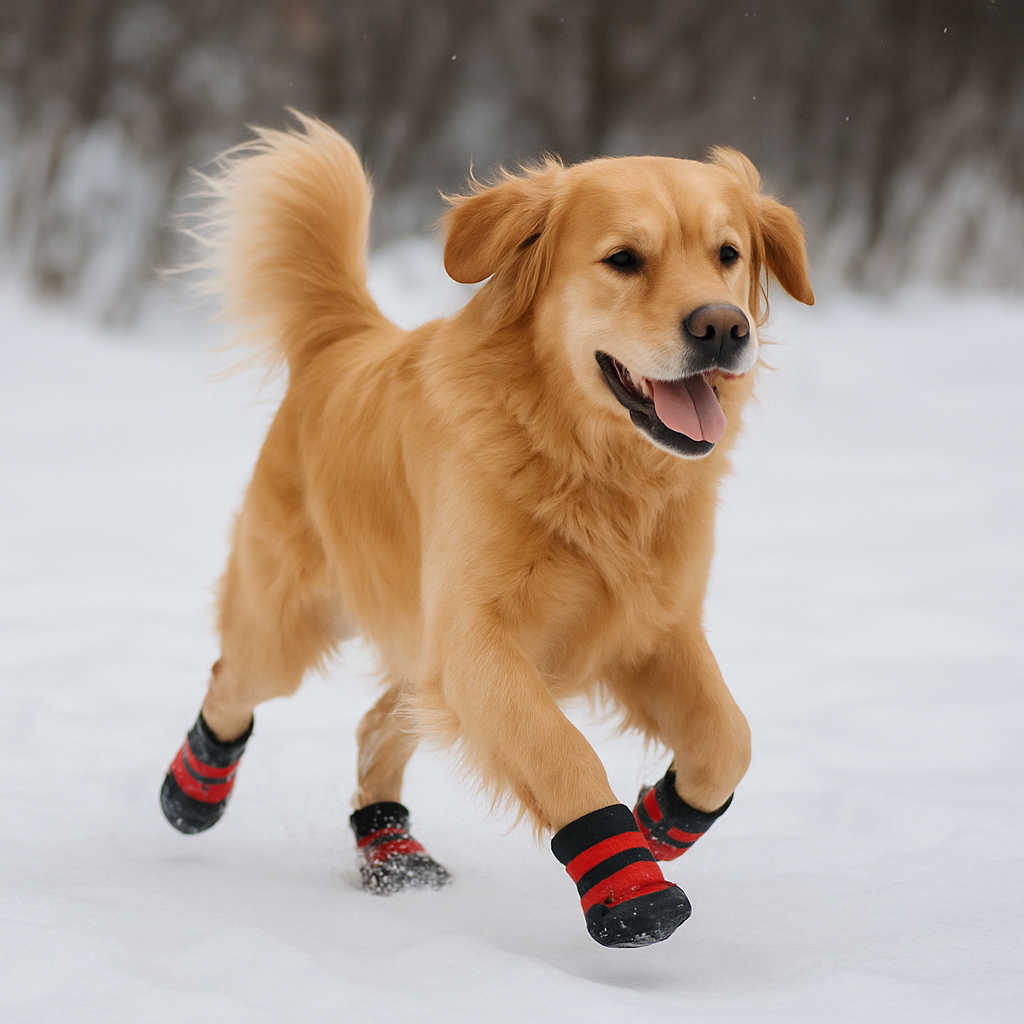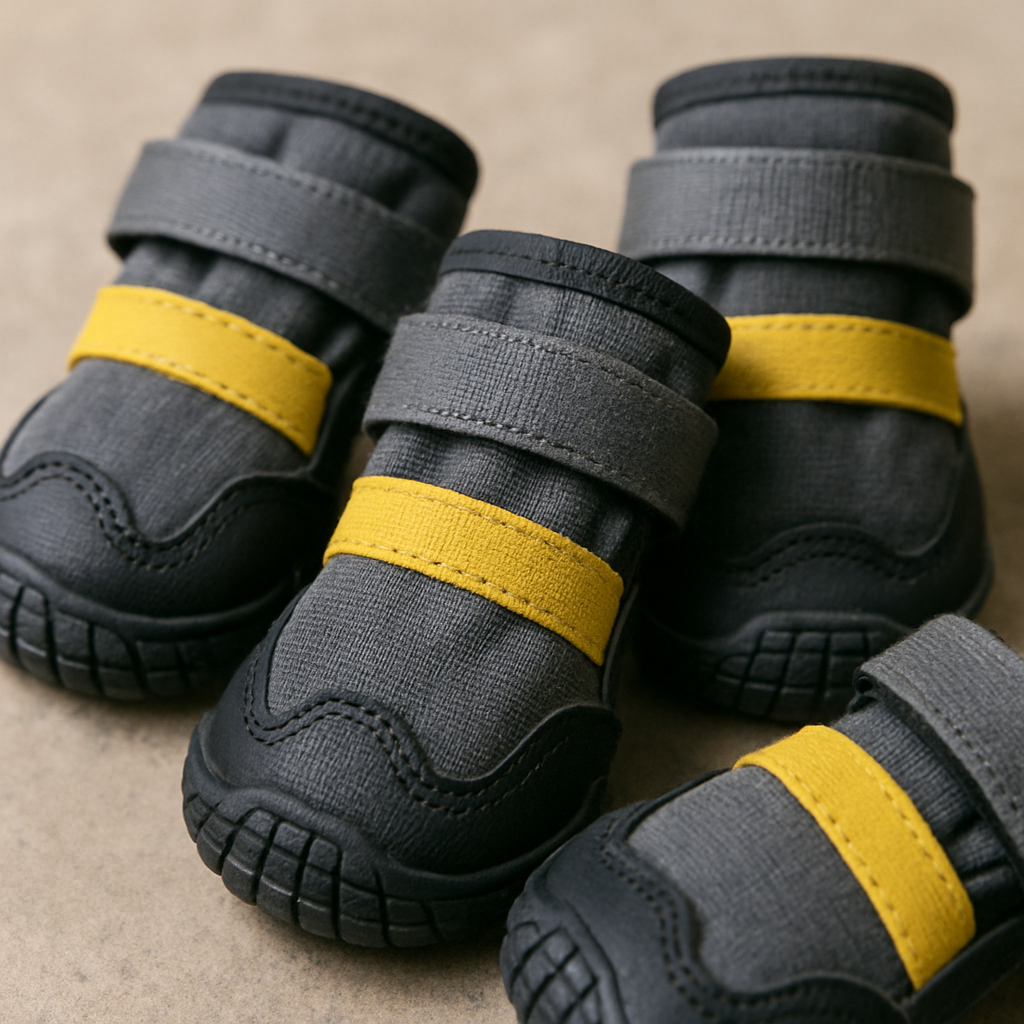Winter poses unique challenges for our beloved canine companions. The cold, ice, and snow can be harsh on a dog's paws, making protection during winter excursions essential. Selecting the right dog boots not only ensures comfort but also enhances your pet's safety and enjoyment of outdoor activities. This guide will help you navigate the various options available, allowing you to make an informed decision for your furry friend.

Protection Against Harsh Elements
Winter conditions can be unforgiving, especially for dogs who love outdoor adventures. The freezing temperatures can lead to frostbite, which is not only painful but can result in long-term damage. Boots act as insulators, keeping your dog's paws warm and safe from frostbite.
Preventing Injuries from Ice and Salt
Ice can be sharp, and salt used for de-icing can irritate your dog's sensitive paw pads. These elements can cause cuts and abrasions, leading to infections if not treated promptly. Dog boots provide a barrier, reducing the risk of such injuries and keeping your pet's paws healthy.
Enhancing Stability on Slippery Surfaces
Winter ice and snow create slippery surfaces, posing a risk for slips and falls. Dog boots with good traction can significantly enhance stability, allowing your pet to move confidently and reducing the likelihood of accidents during play or walks.
The Role of Dog Boots in Different Activities
Different activities require different types of boots. For instance, if your dog is a hunting companion, specialized hunting dog boots are designed to withstand rugged terrains. Similarly, if you enjoy hiking with your dog, investing in durable dog hiking boots can significantly enhance your pet's experience.
Boots for Hunting Dogs
Hunting dogs often traverse challenging terrains, which can be rough on their paws. Specialized hunting boots are designed to withstand such environments, offering protection from thorns, sharp rocks, and extreme weather conditions. They are typically made from durable materials that provide both protection and comfort.
Hiking with Your Dog
For those who love hiking, choosing the right boots for your dog is crucial. Hiking boots for dogs are designed to offer stability and support over uneven ground. These boots often feature reinforced soles and enhanced grip, allowing your dog to navigate trails safely and comfortably.
Casual Winter Walks
Not every outdoor excursion is an extreme adventure. For casual winter walks, lightweight boots can suffice. These boots provide adequate protection from the cold and wet conditions without the bulk of more specialized footwear. They are ideal for everyday use, ensuring your dog's paws remain dry and warm.
Key Features to Consider

Material and Durability
The material of the boot determines its durability and weather resistance. Look for boots made from high-quality, waterproof materials to ensure they can withstand harsh winter conditions. Some canine boots are designed with rugged materials to endure rough terrains, making them ideal for outdoor adventures.
High-Quality Materials
Selecting boots made from high-quality materials ensures longevity. Look for options such as neoprene, rubber, or ballistic nylon, which are known for their durability and resistance to harsh elements. These materials are not only waterproof but also offer excellent insulation, keeping your dog's paws warm.
Weather Resistance
Weather-resistant boots are essential for winter outings. Check for waterproof or water-resistant features that prevent moisture from penetrating the boot. Additionally, consider boots with added insulation for extra warmth, especially in extremely cold climates.
Rugged Design for Tough Terrains
For dogs who frequently explore rugged terrains, boots with a robust design are a must. Reinforced soles and tough exteriors prevent damage from sharp objects and rough surfaces. This design feature ensures your dog's paws remain protected, regardless of the environment.
Fit and Comfort
Proper fit is essential for your dog's comfort. Boots that are too tight can cause discomfort, while those that are too loose may slip off. Measure your dog's paws accurately and refer to the manufacturer's sizing guide. Adjustable straps can help ensure a snug fit, preventing the boots from sliding off during activity.
Accurate Sizing
Obtaining the correct size is crucial for both comfort and function. Measure your dog's paws while they are standing, ensuring you include the width and length. Compare these measurements with the manufacturer's sizing guide to find the best fit for your pet.
Adjustable Features
Many dog boots come with adjustable straps or closures, allowing you to customize the fit. These features are vital in preventing the boots from slipping off during activity. They also provide a snug fit, ensuring your dog remains comfortable throughout their adventures.
Comfort Padding
Some dog boots include comfort padding, which adds an extra layer of cushioning. This padding can make a significant difference for dogs unaccustomed to wearing boots, providing a soft barrier between their paws and the boot material.
Traction and Sole Design
The sole of the boot should provide adequate traction to prevent slipping on icy or wet surfaces. Look for boots with non-slip soles that enhance grip. Some designs mimic the natural contours of a dog's paw, providing added stability and comfort.
Non-Slip Soles
Non-slip soles are essential for maintaining stability on icy or wet surfaces. Look for boots with textured or patterned soles, as these designs offer better grip and traction. This feature is particularly important for active dogs who love to run and play in the snow.
Natural Contour Mimicry
Some boots are designed to mimic the natural contours of a dog's paw. This design provides a more natural feel, allowing your dog to move as they would without boots. It also offers additional stability and comfort, making it easier for your dog to adapt to wearing footwear.
Enhanced Stability Features
Additional stability features, such as reinforced toe caps or heel guards, can provide extra support. These features help protect against impacts and offer a secure fit, ensuring your dog remains safe and comfortable during outdoor activities.
Types of Dog Boots for Winter
The market offers a variety of dog boots, each suited for different needs. Here, we explore some popular types:
Rocket Dog Boots
Rocket dog boots are renowned for their innovative design and superior protection. They often feature high-quality materials and advanced insulation, making them ideal for extreme winter conditions. Their ergonomic design ensures a comfortable fit, allowing your dog to move naturally.
Advanced Insulation
Rocket dog boots typically feature advanced insulation technology, keeping your dog's paws warm in the coldest conditions. This feature is crucial for dogs spending extended periods outdoors, ensuring they remain comfortable and protected from frostbite.
Ergonomic Design
The ergonomic design of Rocket dog boots ensures a natural fit, allowing your dog to move freely. This design mimics the natural movement of a dog's paw, reducing the likelihood of discomfort and making it easier for your dog to adapt to wearing boots.
Superior Protection Features
These boots are built for extreme conditions, offering superior protection against the elements. Features like reinforced toe caps and durable materials provide excellent defense against sharp objects and rough surfaces, making them ideal for adventurous dogs.
Dog Booties
Dog booties are a lightweight option, often used for short walks or mild winter days. While they may not provide the same level of protection as more robust boots, they are easy to put on and comfortable for dogs who are new to wearing boots.
Lightweight and Flexible
Dog booties are designed to be lightweight and flexible, offering a comfortable option for dogs who are new to wearing boots. This design allows for easy movement, making them suitable for short walks and everyday use.
Easy to Put On
One of the main advantages of dog booties is their ease of use. They are simple to put on and take off, making them a convenient option for quick outings. This feature is particularly beneficial for dogs who are not accustomed to wearing footwear.
Suitable for Mild Conditions
While they may not offer the same level of protection as more robust boots, dog booties are suitable for mild winter conditions. They provide basic protection against cold and wet surfaces, ensuring your dog's paws remain comfortable during short excursions.
Waterproof Dog Boots
For areas prone to wet and snowy conditions, waterproof dog boots are essential. They keep your pet's paws dry and warm, reducing the risk of frostbite and discomfort. Look for boots with sealed seams to prevent water from seeping in.
Essential for Wet Conditions
Waterproof dog boots are crucial for areas with heavy snow or rain. They prevent moisture from penetrating the boot, keeping your dog's paws dry and warm. This feature is essential for maintaining comfort and preventing frostbite in wet conditions.
Sealed Seam Construction
Look for waterproof boots with sealed seams, which prevent water from seeping in through the stitching. This construction technique enhances the boot's waterproof capabilities, ensuring your dog's paws remain dry even in the wettest conditions.
Warmth and Comfort Features
In addition to keeping paws dry, waterproof boots often include features for added warmth, such as fleece lining or thermal insulation. These features ensure your dog remains comfortable during cold, wet outings.
Ensuring Proper Paw Protection

In addition to selecting the right boots, consider complementary paw protection strategies. Regularly inspect your dog's paws for signs of irritation or injury. Apply paw balm before and after outings to moisturize and protect the pads. Additionally, ensure that boots are clean and dry before each use to prevent skin issues.
Regular Paw Inspections
Conduct regular inspections of your dog's paws to detect any signs of irritation or injury. Look for cuts, abrasions, or redness, which can indicate discomfort. Early detection allows for prompt treatment, preventing minor issues from becoming serious problems.
Use of Paw Balm
Applying paw balm before and after outings can help moisturize and protect your dog's paw pads. This balm acts as a barrier, shielding against harsh elements and preventing dryness and cracking. Choose a balm with natural ingredients to avoid irritation.
Maintaining Boot Hygiene
Ensure your dog's boots are clean and dry before each use to prevent skin issues. Wet or dirty boots can lead to irritation or infections, so regular cleaning and drying are essential. This practice also prolongs the life of the boots, ensuring they remain effective.
Tips for Introducing Dog Boots
Introducing your pet to boots requires patience and positive reinforcement. Begin by allowing your dog to sniff and explore the boots. Gradually introduce them by having your dog wear the boots indoors for short periods, rewarding them with treats and praise. This acclimatization process helps your dog feel comfortable and confident wearing boots outdoors.
Initial Exploration
Start by letting your dog explore the boots at their own pace. Allow them to sniff and investigate the new items, helping them become familiar with the boots' presence. This initial exploration is crucial for reducing anxiety and building curiosity.
Gradual Introduction
Introduce the boots gradually, beginning with short indoor sessions. Have your dog wear the boots for brief periods, gradually increasing the duration as they become more comfortable. This gradual process helps your dog adjust to the sensation of wearing boots.
Positive Reinforcement
Use positive reinforcement to encourage your dog during the acclimatization process. Offer treats and praise when your dog wears the boots, associating the experience with positive outcomes. This reinforcement boosts confidence, making outdoor adventures more enjoyable.
Conclusion
Selecting the best dog boots for winter is a vital step in ensuring your pet's safety and comfort during the colder months. By understanding the unique needs of your dog and considering the activities you'll engage in, you can choose boots that offer the perfect balance of protection, durability, and comfort.
Whether you're seeking hunting dog boots, dog hiking boots, or simply reliable winter dog boots, investing in quality canine footwear will enhance your pet's well-being and enjoyment of outdoor adventures. With the right boots, you and your furry friend can embrace the winter season with confidence and joy.






